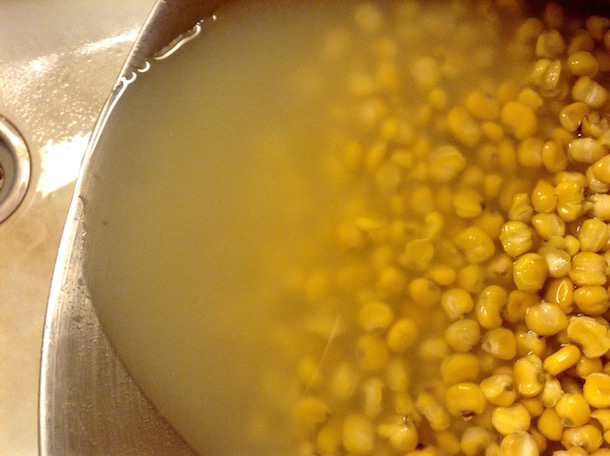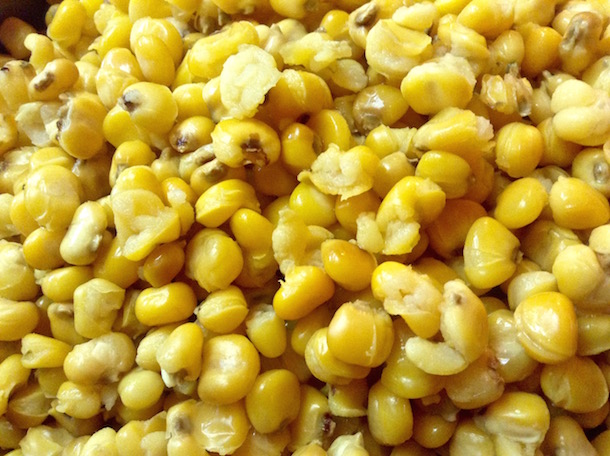Hominy
Making hominy gets to the core of slow food cooking. It’s a process that takes forethought and time, and though the concept is understandable the Complexities of Simplicity emerge. Simple is not necessarily simple.
Pre-Columbian cultures began the practice of ‘nixtamalization’ in Mesoamerica. It involes soaking the kernels of maize in alkaline wood ash to release protein, calcium, niacin and other micro-nutients, and removes fungal-mycotoxins from stored corn. They then rinsed and slow-cooked the soaked corn in clay pots and ate it whole or ground it on a metate (grinding stone). Nixtamal was a sacred staple of their diet and culture.
These days we generally soak the corn in ‘pickling lime’ (calcium hydroxide), rinse it, slow simmer it for hours in crockpots or slow-cookers (if making it at home), rub the kernels to remove the hulls, and call the resulting chewy kernels ‘hominy’ (from anglicized Algonquin) or ‘posole’ (Nahuatl). Hominy is used to make grits or posole the soup, or grind it into masa for tortillas, tamales, gorditas, and a host of other delicious dishes.
A cautionary note about culinary or pickling lime: it’s extremely alkaline so use caution when handling, be careful of touching it with bare skin, and rinse the corn well after soaking.
There is a pile of information out there about making hominy and I found it to be somewhat inconsistent. How long to soak the corn, the proportion of lime, how long to cook…there are varying recipes depending on personal opinions and the intended use of the hominy.
Anson Mills, a producer of heirloom grains, digs into the recipe research and last summer their chef talked me through the process of making hominy. I was introduced to the South Carolina based Anson Mills a few years ago when they provided the Carolina Gold Rice grits so I could make Rice Grits Cakes for the Seed Savers conference a few years ago. They provided me with Hominy Corn for the same conference last summer and I’m once again wowed by their commitment to integrity and incredible product.
Read a little more about What They Do.
From Anson Mills:
“Its precise origins aside, early nixtamal cookery involved wood ash, water, and maize. Properly concentrated, wood ash and water form a naturally caustic chemical called potassium hydroxide (colloquially, potash) that dissolves pericarp (the cellophane stuff that gets stuck in your teeth when you eat popcorn) straight off the kernels. The kernels are left plump, naked as a baby, and infused with an intoxicating flavor that is part corn, part exotic spice, and part mysterious scents that seem to alert your primal sensors to anticipate exceptional nutrition. It is an authentic American flavor very few of us have experienced. But you can experience it now.”
I totally agree—it is a scent that takes you back, or in, or out…it definitely takes you somewhere and inhaling a deep whiff of the simmering hominy is worth all the effort of making it. Since they describe it so well, here is the recipe from Anson Mills for this slow-food intoxicating flavor:
Fresh Whole Hominy
At the Seed Savers Conference I made the Anson Mills hominy into Gorditas and served them with a Cubano Trio of Meats (Ham, Bacon and Smoked Pork), a Pinto Vegetable Salad, New Mexico Chile Lime Slaw, and Baguettes with a Tamarind Fig Butter. The texture would have been smoother had I used a grinder instead of the food processor for grinding the hominy into masa, but it was a mighty tasty meal nonetheless.
A few recipes for your fresh hominy:
- Masa Tortillas
- Arepas, Pupusas and Gorditas
- Tamales Pequeños
- Huarachitos
- Posole Rojo
- Lost and Found Chili (a quick-nixtamalization)
- Fresh Hominy Grits
Growing up on a farm meant we always had access to piles of corn should we need some gold in our satchels when taking rides on the ponies. The golden abundance made us feel rich and I’ve always loved having some kernels around. This is a statue from Hermosillo in northern Mexico, a poncho my parents brought back from Bolivia, Henry Moore yellow hominy corn from Anson Mills, and a sweet basket woven and given to me by an instructor years ago at the Willow Gathering.
“Nya b’a’n tu’n t-xi tewin chib’aj cye tuliy, ku’n ajo chib’aj b’e’x cy-elil× chuk-ix.
It is not good to hide good food from visitors because it will turn into worms.”
.
Mayan Proverb





